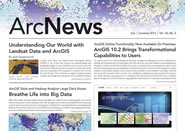Landsat data from the United States Geological Survey (USGS) is one of the best sources for understanding and analyzing changes to our world that have occurred over the last 40 years. With the launch of Landsat 8 in February of this year, the continuity of the program is assured into at least the next decade. Esri continues to support making Landsat imagery and image processing part of our platform and has recently added more capabilities to ArcGIS that make it even easier to analyze and enhance Landsat data.
A Platform for Remote Sensing
Over the past several years, Esri has made major investments in enhancing the ArcGIS platform with image processing tools for visualization, analytics, and data management. This includes implementing dozens of high-performance image processing capabilities within the ArcGIS desktop and server environments. In addition, Esri has implemented online and on-demand image serving capabilities and made them available to GIS organizations around the world.

Working collaboratively with USGS, Esri hosted 40 years of Landsat Global Land Survey scenes in the cloud as dynamic image services for people everywhere to access. These image services take the multispectral imagery and process it on demand. They can be used in a wide range of applications for visualization of different multispectral enhancements; computation of products, such as vegetation indexes; and dynamic change analytics. Millions of users have access to these services and can look through time and see how Landsat has documented changes on the earth’s surface. Esri also created an online Landsat analysis application as part of an initiative called Change Matters, which enables dynamic image processing of the entire planet.
Esri also helped USGS stand up its own dynamic image services using the ArcGIS platform at the Earth Resources Observation and Science (EROS) Data Center for a USGS initiative called LandsatLook. This set of services allows users to zoom in to any location and see the full-resolution data of all the Landsat scenes available. In many places, there are more than a thousand scenes taken at different times, providing an unprecedented opportunity to visualize temporal change. Not only can people see how the planet is changing with LandsatLook, but they can also access the full metadata and, if required, download the multispectral scenes. These services provide access to the complete archive of all Landsat data, going all the way back to 1973 and including scenes from the Landsat Multi-Spectral Scanner (MSS). USGS updates the LandsatLook services as new imagery is released from the existing Landsat 7 satellite and very soon will be updating it with the new Landsat 8 imagery when it becomes available.
In addition to the simple Change Matters application and USGS LandsatLook services, the Landsat image services are available on ArcGIS Online and for ArcGIS desktop and server users throughout the Esri community. The ease of access to this data through online image services has resulted in significant benefits to GIS users around the world.

Landsat 8 Launch
Working closely with USGS, the National Aeronautics and Space Administration (NASA) launched Landsat 8 earlier this year, providing a new global multispectral imagery data collection platform. Landsat 8 provides complete coverage of the world every 16 days, with clear coverage depending on clouds and other atmospheric conditions. It provides continuity to the previous sensors and also adds new multispectral and thermal bands to enable additional analysis.
Esri is exploring standing up Landsat 8 imagery as a web service through ArcGIS for use both as background image maps and for imagery analysis. Key to this new service is the rapid availability of the new Landsat imagery after it is acquired. This will allow users to enjoy the full benefits of fresh multispectral imagery content anywhere on the planet.
Esri wishes to acknowledge and thank the US government (NASA and USGS) for its contributions and for providing this strong science foundation of earth measurement and monitoring data.
A Complete Imagery Solution
In addition to enriching ArcGIS with technology enhancements for Landsat and remotely sensed data, Esri is also providing easy access to collections of other sources of remotely sensed imagery data. This includes cached DigitalGlobe imagery of the entire planet as a basemap, 40 years of Landsat image services from historical Landsat imagery, and global elevation data; in the future, it will include dynamic services from a variety of commercial partners (DigitalGlobe; RapidEye; AccuWeather, Inc.; etc.). This ensures that users will be provided with a complete imagery solution through the ArcGIS platform.


